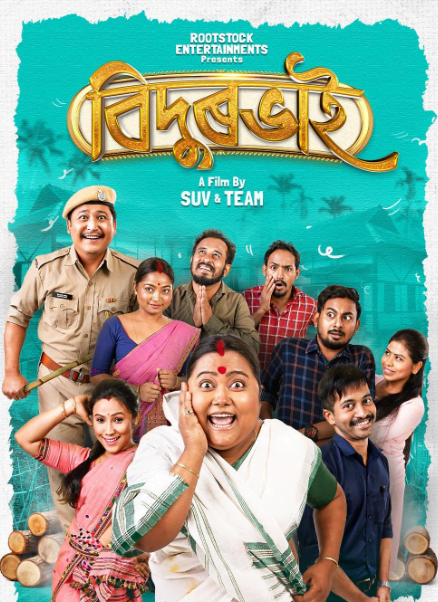The North East region of India is by no means a homogenous entity. Each state has its heterogenous mixture of ethnicities, communities, and cultures coexisting together. The region as a whole, though, has been historically insurgent, terrorised, and largely cut off from the mainstream national discourse. However, despite everything, voices from the North East have found their way to exist amidst their dystopian realities. Life goes on, and despite the many plenitude of problems that pose a hurdle in the region, the richness of culture and way of life find expression and celebration in the regional cinema of the states.
What goes missing, however, is the representation of the lives of queer people in the regions. While the regional cinema of the North Eastern states addresses one layer of nuance, which is the portrayal of the different shades of regionality and cultural identity, the other layers of nuance often go missing in terms of queer sensibility and sensitivity to questions of gender and sexuality, which are the cornerstones of queer narratives.
In the first place, the presence of queer cinema is very negligible in the region, but for the scope of streamlining the discussions, the conversation is centred around Assamese cinema and Manipuri cinema, since there seems to be known and accessible queer cinematic portrayals in these two states.
Problems of accessibility and informed representation
Right off the bat, the problem that one runs into while trying to write about the representation of queer lives in the North East region is the problem of accessibility. Queer cinema exists along the margins of an already marginalised region, so the limited number of queer films that do exist in the region remain inaccessible to audiences. This includes the unavailability of the films online and over OTT platforms, the inaccessibility of subtitles, and a lack of media coverage and information overall.
Shivalal is a queer-rights activist and the co-founder of Xomonnoy, a queer rights organisation based in Assam, and co-organiser of the Annual Queer Pride Guwahati. Shivalal comments on the lack of resources which the region suffers from at large, ‘Regional cinema in the context of the North East is very niche and rooted with the cultural context, which does not catch the national interest. The industry works on very limited and scarce resources along with many structural challenges, almost working in a survival mode. In the context of queer narratives, it is doubly negligible.’
Priyakanta Laishram is a queer film director, actor, and LGBTQI activist based in Manipur who has been widely praised for his groundbreaking ventures into representing queer lives and topics in Manipuri cinema. Priyakanta Laishram comments, ‘Firstly, we have a limited number of queer writers and filmmakers, even though queer individuals dominate fields like make-up, costume, and styling. In the few films made over the years, many either misrepresented the community or portrayed them as mere caricatures.’
‘My 2015 short film, “IT’S NOT MY CHOICE,” starring a transgender actor, Bishesh Huirem, was the very first Manipuri queer film that was written by a queer writer and director. Secondly, mainstream filmmakers, apart from being less aware of the community, often hesitate to create films on such topics due to the fear that audiences might not support them, given that society still has a long way to go in accepting LGBTQ identities,’ says Priyakanta.
Priyakanta also points out, ‘Specifically in Manipur, transgender people hold significant roles in art, culture, and the beauty industry. However, a few films produced on transgender themes have largely been commercially unsuccessful. Additionally, it’s challenging for Northeast filmmakers to find distributors, which is another reason why our films are not available on mainstream OTT platforms. Distributors often overlook films from our region due to the perceived limited market and reach. These factors all contribute to the scarcity and limited accessibility of queer films in the Northeast.’
Misrepresentation of queer lives in the existing dearth of queer representation
Shivalal points out the large misrepresentation and lack of sensitivity that exists within the Assamese cinema at large while dealing with queer portrayals on screen. ‘Queer representation in Assamese cinema is still stuck in the 90s, like one you would see in the no-brainer David Dhawan films. There have been some very rare good representations, but it suffers from a lack of support and solidarity within the industry. Anything can be made on the topic of queer lives, and no recognised body is there to hold makers accountable for harmful representations. The normalised transphobia and homophobia create more divides in society. We are already at the margins, so in times of any crises, we are one of the first to be affected and targeted. Let us be responsible with the representations if we have the resources to create the film.‘
Rajesh Paul is a queer activist from Assam who affirms the statement, ‘While it’s true that Assamese cinema has begun to explore queer themes, I have observed that the portrayal often falls short of being authentic or respectful. The characters are frequently reduced to stereotypes or used as comedic relief rather than being depicted with the depth and dignity they deserve. This not only perpetuates harmful misconceptions but also alienates the very community these films claim to represent.’
Taking an example of Bidurbhai (2024), directed by Suvrat Kakoty, Rajesh brings attention to the insensitive representation of queer lives and the harmful portrayal of male sexual assault by the film and the industry at large. ‘The inclusion of a queer character, only to portray them in a derogatory manner with mocking music and gestures, is unacceptable. When the victim went to take a shower afterward, I initially thought the film would address the real trauma of such incidents. Instead, it turned into a comedic element that made the audience laugh even though the victim was crying in the scene, which was extremely uncomfortable to watch. The director, who is also the writer, did include a line towards the end stating,“Lora manuhor logotu dhorkhon hoi” (men can also be victims of sexual assault), but this did not justify the mockery preceding it. Even when the film acknowledged the harsh reality of male rape, the audience continued to laugh due to the comedic background music and the mocking portrayal. This powerful line went unnoticed and was treated as a joke because the intention of highlighting male rape did not come from a place of honesty.‘

Rajesh further says, ‘It has undertones of homophobia and insensitivity towards male victims. As a queer person and a survivor of male sexual assault, it made me feel uncomfortable and unsafe in the theatre; it left me with a profound sense of sorrow, realising that our emotions seem to hold no value, neither in the real world nor in the reality of our lives.’
Shivalal also shared how in another one of these films, a commercially famous actor portrayed a very hurtful representation of queer lives, and they were asked to endorse the film, ‘There is a film where a famous Assamese actor enacted a gay man’s role, the film was full of hurtful stereotypes about same-sex relationships. The saddest part was that we were asked to endorse the movie. The makers knew us personally, but nowhere in the screenplay or dialogues did they ever consult or contact us throughout the making of the movie, but only when the end product was finalised. We of course refused to promote this movie about harmful stereotypes about the community.’
A ray of hope: some sensitive portrayals of queer experiences
“Fireflies- Jonaki Porua” directed by Prakash Deka is the first groundbreaking Assamese film with a queer theme, which has been widely recognised and garnered critical acclaim nationally and internationally for its deeply moving and sensitive portrayal of an Assamese transgender woman’s experience and coming to terms with her gender identity. Amidst the bleak darkness of her life, Jahnu twinkles like a beautiful firefly and transitions to Jahnabi.

The film captures the nuances of Jahnabi’s gender dysphoria, self-estrangement, and isolation when she lived as a man, and subsequently how the hijra community welcomed her with open arms to give her the space where she became more connected with herself. However, despite the transition, the feeling of disconnect never truly disappeared, and the film perfectly captures the nuances of her journey as a transgender woman. Other than the story of the protagonist, there are many other characters in the film whose carefully crafted portrayal showcases the wide range of the queer spectrum and experiences.
Shivalal observes the film’s acclaim, ‘Fireflies- Jonaki Porua is a remarkable film on the life of a transgender woman, enacted and produced by people from the LGBTQI community. It won a national award, but it is not recognised as a game changer in the Assamese industry when it rightfully deserves to be. The lack of acknowledgement and acceptance towards the film reflects the societal attitudes towards us, the queer community, because, as we know, cinema is not in isolation. Unfortunately, films like Bidurbhai with their harmful portrayal are doing well commercially, catching national attention and giving out the wrong message, while we did not have that kind of support with authentic queer-centric movies like Jonaki Porua.’
There have been other sensitive and informed portrayals of queer characters and homosexuality in the Assamese industry as well, with Rima Das’ “Bulbul Can Sing” which also gained acclaim for its thoughtful and nuanced takes on gender and sexuality through the queer character of Suman, and the beautiful metaphorical imagery of Assam’s natural landscape, which culminates in a majestic rainbow of self-acceptance towards the end of the film. There is also a documentary film “Children of God (2022)” directed by Parthajit Baruah, which features a lesbian couple, Sanam Chaudhary and Aneez Saikia from Assam, whose story has also been covered under the web series Rainbow Rishta on Amazon Prime Video.

In Manipur, Priyakanta Laishram has been hailed as the ‘torchbearer of Manipur queer cinema,’ for his dedicated work towards releasing queer-centric films like “It’s Not My Choice (2015),” “Who Said Boys Can’t Wear Makeup (2018),” and “The Foul Truth- Amakpa Achumba (2019),” dealing with topics like transgender representation, gender, identity, and male sexual assault. His recent film “ONENESS (2024),” which debuted at the KASHISH Pride Film Festival 2024 in May, is based on the real-life case of the honour killing of Ivan, a gay teenage boy, in 2013.
Laishram is hopeful for the film to reach more audiences in the later part of the year, ‘My 2024 feature film ‘ONENESS’ is the first Manipuri film to focus on same-sex relationships. While it has been screened at various film festivals, I am also planning a theatrical release by the end of this year. We are currently in the process of obtaining censor certification. I believe that taking a little risk and showing some courage can lead to significant change. Fingers crossed!‘
Queer people have always found ways to carve their space amidst this patriarchal and heteronormative world order. The question of queer representation in the North East becomes even more challenging to deal with when you take a look at the region’s complexity of issues. However, the existence of a parallel, subversive, and authentic Queer cinema and narratives in the North East has slowly been on the rise, against all odds.
About the author(s)
Sarah (She/Her) is your local student journalist and writer pursuing her Bachelor's in Literature from Delhi University. She seeks to strike a balance between a chaotic chronically online gen-z and an insatiable learner. At the risk of coming across as cheesy, she quotes Oscar Wilde on being asked to introduce herself, "To define is to limit."





